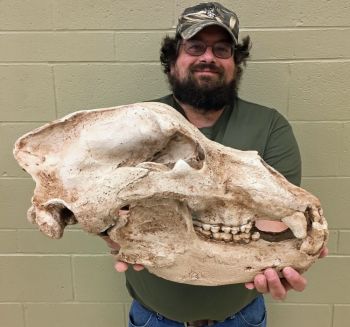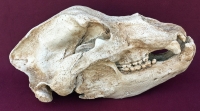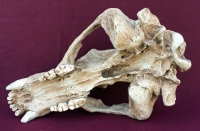
The cave bear (Ursus spelaeus) was a species of bear that lived in Europe and Asia during the Pleistocene and became extinct about 24,000 years ago during the Last Glacial Maximum.
Both the word "cave" and the scientific name spelaeus are used because fossils of this species were mostly found in caves. This reflects the views of experts that cave bears may have spent more time in caves than the brown bear, which uses caves only for hibernation
Many caves in Central Europe have skeletons of cave bears inside, for example the Heinrichshöhle in Hemer, and the Dechenhöhle in Iserlohn, Germany. A complete skeleton, five complete skulls, and 18 other bones were found inside Jaskinia Niedźwiedzia (en. Bear cave) in Poland. In Romania, a cave called Bears' Cave, 140 cave bear skeletons were discovered in 1983.
The cave bear had a very broad, domed skull with a steep forehead. Its stout body had long thighs, massive shins and in-turning feet, making it similar in skeletal structure to the brown bear. Cave bears were comparable in size to the largest modern-day bears. The average weight for males was 350 to 600 kg (770 to 1,320 lb), with an exceptional specimen weighing 817 kg (1,800 lb) or more, while females weighed 225 to 250 kg (495 to 550 lb). Of cave bear skeletons in museums, 90% are male due to a misconception that the female skeletons were merely "dwarfs". Cave bears grew larger during glaciations and smaller during interglacials, probably to adjust heat loss rate. Adults ranged in size from 2.1 to 3 meters (6 feet 8 inches to 9 feet 8 inches) with the largest being 10 feet tall standing on hind legs.
Resin Cast
21 x 12 x 11.5 inches
Item 3782
Category: Replicas
Type: Skulls
Phylum: Vertebrates
Class: Mammals
MORE PHOTOS:




Now Over 1,000 Items!
PrehistoricStore.com offers the largest selection of replica fossils and other fossil-related products anywhere in the world!
Download a Full Catalog (3MB PDF)
OVER 260 PAGES OF REPLICAS AND MORE!
